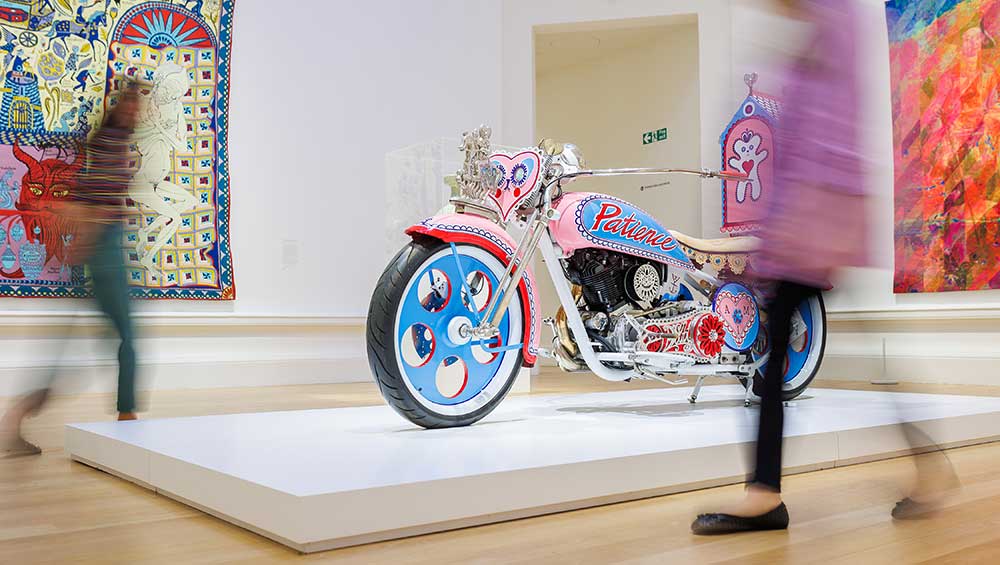
Grayson Perry: Smash Hits, installation view. Photo: Nick Mailer Photography.
National Galleries of Scotland (Royal Scottish Academy), Edinburgh
21 July – 12 November 2023
by CHRISTIANA SPENS
In some respects, it is bizarre to come to the Royal Scottish Academy during the Edinburgh art festival and find a sprawling and intense dissection of English middle-class identity; in other respects, I can see why such a discourse would find its natural home here. Scotland is a safe space to dissect the English, historically speaking, and Essex-born Grayson Perry makes good use of it, packing so much energy, angst and culture cringe into the galleries of the RSA.
It is perhaps useful, too, for the audiences to see Perry’s work with a degree of distance from its subject. Having grown up in Scotland, but now living in London (with a fair amount of ambivalence myself), I found the juxtaposition interesting – not least because the festival is often felt by locals to be an imposition of mostly English people on the city. And yet, in an economic sense, Edinburgh requires these passing visitors to function, as it depends on tourism all year round to some degree. In this, and more generally, the Scottish presently depend on the English to get along, by bickering arrangement if not ultimate necessity.
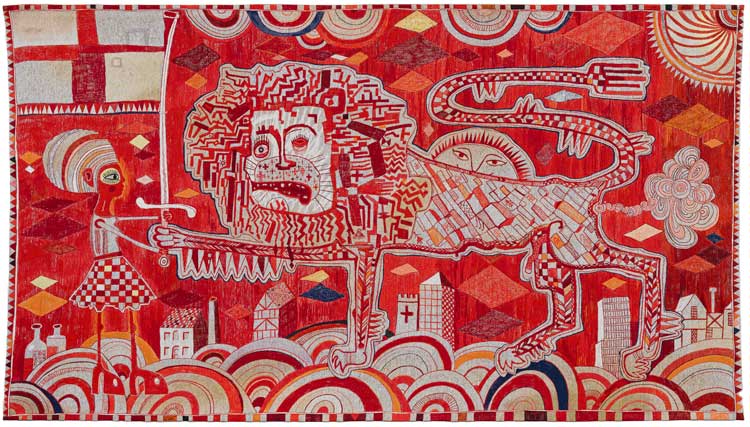
Grayson Perry, Sacred Tribal Artefact, 2023. Tapestry, 200 x 350 cmn (78 3/4 x 137 3/4 in). © Grayson Perry. Courtesy the artist, Paragon | Contemporary Editions Ltd and Victoria Miro.
To headline an English artist picking apart many of the worst qualities of Englishness is a funny spin on this dynamic, anyway. And many of those flaws and irritants are here for all to see – in detailed maps of perversions and problems. There is The Vanity of Small Differences, Grayson’s update of Hogarth’s Rake’s Progress, in which, over six large tapestries, the protagonist, Tim Rakewell, traverses class boundaries to becomes a tech billionaire. In these elaborate works, Perry depicts tormented, tattooed men and moody women, naked and jaded in the sleaze all around them, holding babies and phones. It is Essex, Perry’s home town, but it’s also Brighton, Margate and London; it is reality TV embroidered into silk, machismo repurposed and fetishised, commodified and coveted, but also repellent, still. There is a devil seeming to suck from vases labelled PG Tips, Tiffany, Post Office, The National Trust, these labels garish, intriguing detritus, cast around haphazardly and compulsively, or babble from a manic episode. There are beautiful, intricate maps of England and of the subconscious of the artist, and elegant, melancholic figures painted on to vases. This is an outpouring, and having these vases dotted around only underlines that feeling of a deluge – an island and a person sinking in these problems, which the little vases would never have been capable of containing anyway.
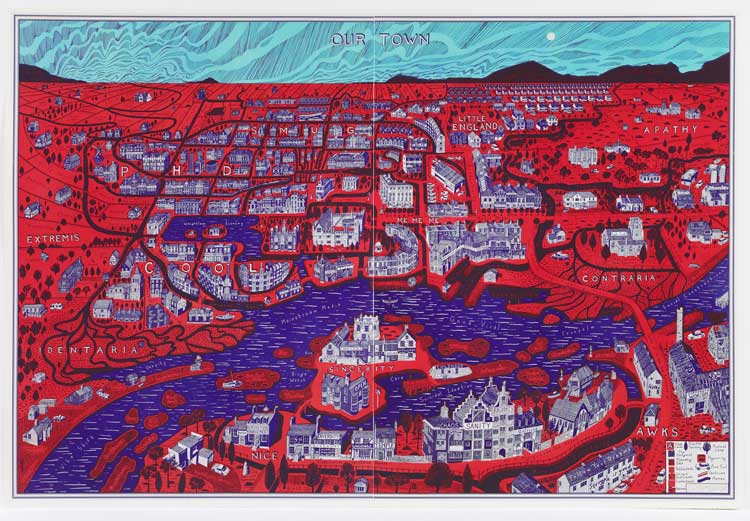
Grayson Perry, Our Town, 2022. Etching, 109 x 161 cm (42 ⅞ × 63 ⅜ in). © Grayson Perry. Courtesy the artist, Paragon | Contemporary Editions Ltd and Victoria Miro.
Haunting the exhibition is Perry’s own friendly ghost, Alan Measles — his teddy bear from birth, and now a longstanding personal totem, verging on Dorian Gray-like significance. In the summer of Barbie fever, I found it interesting to see another toy being used as a plaything of the communal unconscious, in which we may project various present issues on to an inanimate object charged with apparently endless symbolic meaning. While in Greta Gerwig’s Barbie, the human characters create a fissure between the Barbie world and the real world by projecting their existential dread and thoughts of death on to the doll, thus creating a widespread social panic, here Perry’s bear becomes the means by which he can communicate his childhood memories of loneliness and alienation, and also drive home the psychoanalytic thought that underlies much of his work. We even have a bronze called Alan Healing the Wound, in which the bear is hugging the artist’s inner child.
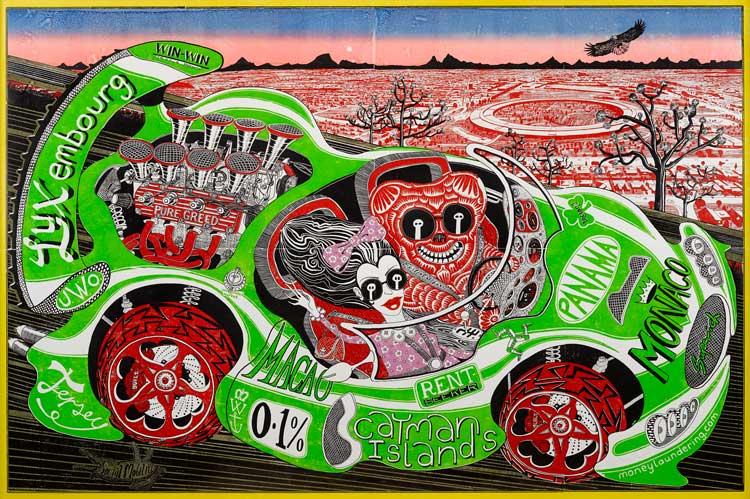
Grayson Perry, Sponsored by You, 2019. Woodblock print, 215 × 320 × 10 cm (84 ⅝ × 126 × 4 in). © Grayson Perry. Courtesy the artist, Paragon | Contemporary Editions Ltd and Victoria Miro. Photo: Jack Hems.
As I walk around, I am also reminded of two recently departed characters – the writer Martin Amis and the comedian Barry Humphries, both of whom revelled in mocking the English and their particular (and indeed peculiar) cultural signifiers. If Amis’s London Fields and Money or Humphries’ Lionel Asbo had been created in tapestry form, I imagine they would look something like this. And although not as sharp or raucous, Perry’s performative side has been influenced by Humphries’ alter ego Dame Edna Everage, an Australian who mocked the English motherland incessantly and brilliantly. Indeed, satire is a very English tradition. It is a mildly sadistic probing of flaws and perversions, a sniggering poke at the shared weirdness of this repressed, fractured isle – and with the Edinburgh fringe in the background, the comic element of Perry’s work is a clever fit.
Underlying the comedy in Perry’s work is a familiar yearning for home twinned with a desire to escape it, while never being able to fully go back or leave, and so remaining in the limbo of one’s own strained consciousness. Presenting a complex intertwining of childhood and place, Perry’s work is a vision of the artist’s subconscious, which can surely speak to us all, in which we are suspended in the trappings of childhood and the past – whether individually or as a collective (and perhaps even as a country, as Perry obviously suggests).
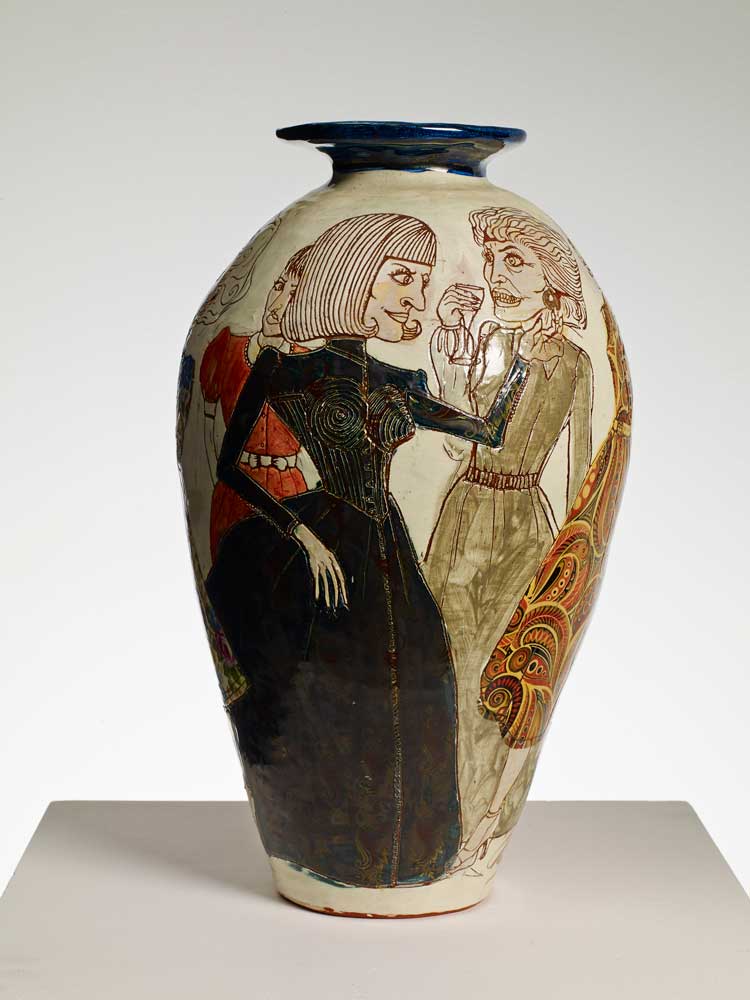
Grayson Perry, Cocktail Party, 1989. Glazed Ceramic, 41 x 22 x 22 cm (16 1/8 x 8 5/8 x 8 5/8 in). © Grayson Perry. Courtesy the artist and Victoria Miro.
On this occasion, then, the English artist has come to Edinburgh in a quasi-therapeutic relationship, as English artists do every year — to spill the stories that weigh them (and us) down, to find attention, affirmation and a change of scene, and the promise of leaving again, going home, until the next session. And yet home can be not merely the place we leave or try to escape, but also the place we go back to, to explore more recent issues, whether rooted in childhood or not. For those who return to England, however, the strange, poisoned nostalgia and the pain of its past, which is represented in this Smash Hits of common perversion, shame and sentimentality, may prove endlessly claustrophobic and inescapable — an exhibition of nightmares with no clear exit.